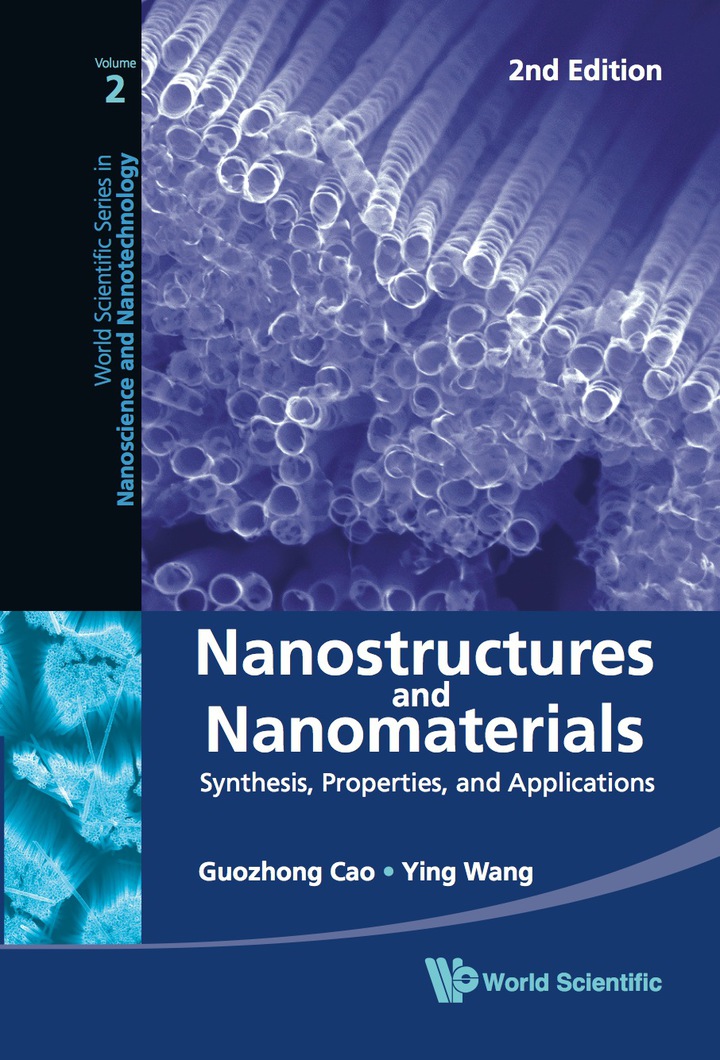Nanostructures and Nanomaterials Synthesis, Properties, and Applications 2nd Edition by Guozhong Cao, Ying Wang ISBN 981310077X 9789813100770
$70.00 Original price was: $70.00.$35.00Current price is: $35.00.
Instant download Nanostructures and Nanomaterials Synthesis Properties & Applications after payment
Nanostructures and Nanomaterials Synthesis, Properties, and Applications 2nd Edition by Guozhong Cao, Ying Wang – Ebook PDF Instant Download/Delivery: 981310077X, 9789813100770
Full dowload Nanostructures and Nanomaterials Synthesis, Properties, and Applications 2nd Edition after payment

Product details:
ISBN 10: 981310077X
ISBN 13: 9789813100770
Author: Guozhong Cao, Ying Wang
This is the 2nd edition of the original “Nanostructures and Nanomaterials” written by Guozhong Cao and published by Imperial College Press in 2004.This important book focuses not only on the synthesis and fabrication of nanostructures and nanomaterials, but also includes properties and applications of nanostructures and nanomaterials, particularly inorganic nanomaterials. It provides balanced and comprehensive coverage of the fundamentals and processing techniques with regard to synthesis, characterization, properties, and applications of nanostructures and nanomaterials. Both chemical processing and lithographic techniques are presented in a systematic and coherent manner for the synthesis and fabrication of 0-D, 1-D, and 2-D nanostructures, as well as special nanomaterials such as carbon nanotubes and ordered mesoporous oxides. The book will serve as a general introduction to nanomaterials and nanotechnology for teaching and self-study purposes.
Nanostructures and Nanomaterials Synthesis, Properties, and Applications 2nd Table of contents:
Chapter 1 Introduction
1.1. Introduction
1.2. Emergence of Nanotechnology
1.3. Bottom-Up and Top-Down Approaches
1.4. Challenges in Nanotechnology
1.5. Scope of the Book
References
Chapter 2 Physical Chemistry of Solid Surfaces
2.1. Introduction
2.2. Surface Energy
2.3. Chemical Potential as a Function of Surface Curvature
2.4. Electrostatic Stabilization
2.4.1. Surface charge density
2.4.2. Electric potential at the proximity of solid surface
2.4.3. Van der Waals attraction potential
2.4.4. Interactions between two particles: DLVO theory
2.5. Steric Stabilization
2.5.1. Solvent and polymer
2.5.2. Interactions between polymer layers
2.5.3. Mixed steric and electric interactions
2.6. Summary
References
Chapter 3 Zero-Dimensional Nanostructures: Nanoparticles
3.1. Introduction
3.2. Nanoparticles Through Homogeneous Nucleation
3.2.1. Fundamentals of homogeneous nucleation
3.2.2. Subsequent growth of nuclei
3.2.3. Synthesis of metallic nanoparticles
3.2.4. Synthesis of semiconductor nanoparticles
3.2.5. Synthesis of oxide nanoparticles
3.2.6. Vapor phase reactions
3.2.7. Solid-state phase segregation
3.3. Nanoparticles Through Heterogeneous Nucleation
3.3.1. Fundamentals of heterogeneous nucleation
3.3.2. Synthesis of nanoparticles
3.4. Kinetically Confined Synthesis of Nanoparticles
3.4.1. Synthesis inside micelles or using microemulsions
3.4.2. Aerosol synthesis
3.4.3. Growth termination
3.4.4. Spray pyrolysis
3.4.5. Template-based synthesis
3.5. Epitaxial Core–Shell Nanoparticles
3.6. Summary
References
Chapter 4 One-Dimensional Nanostructures: Nanowires and Nanorods
4.1. Introduction
4.2. Spontaneous Growth
4.2.1. Evaporation (dissolution)-condensation growth
4.2.2. Vapor (or solution)–liquid–solid (VLS or SLS) growth
4.2.3. Stress-induced recrystallization
4.3. Template-Based Synthesis
4.3.1. Electrochemical deposition
4.3.2. Electrophoretic deposition
4.3.3. Template filling
4.3.4. Converting through chemical reactions
4.4. Electrospinning
4.5. Lithography
4.6. Summary
References
Chapter 5 Two-Dimensional Nanostructures: Thin Films
5.1. Introduction
5.2. Fundamentals of Film Growth
5.3. Vacuum Science
5.4. Physical Vapor Deposition (PVD)
5.4.1. Evaporation
5.4.2. Molecular beam epitaxy (MBE)
5.4.3. Sputtering
5.4.4. Comparison of evaporation and sputtering
5.5. Chemical Vapor Deposition (CVD)
5.5.1. Typical chemical reactions
5.5.2. Reaction kinetics
5.5.3. Transport phenomena
5.5.4. CVD methods
5.5.5. Diamond films by CVD
5.6. Atomic Layer Deposition
5.7. Superlattices
5.8. Self-Assembly
5.8.1. Monolayers of organosilicon or alkylsilane derivatives
5.8.2. Monolayers of alkanethiols and sulfides
5.8.3. Monolayers of carboxylic acids, amines, and alcohols
5.9. Langmuir–Blodgett Films
5.10. Electrochemical Deposition
5.11. Sol–Gel Films
5.12. Summary
References
Chapter 6 Special Nanomaterials
6.1. Introduction
6.2. Carbon Fullerenes and Nanotubes
6.2.1. Carbon fullerenes
6.2.2. Fullerene-derived crystals
6.2.3. Carbon nanotubes
6.3. Micro and Mesoporous Materials
6.3.1. Ordered mesoporous structures
6.3.2. Random mesoporous structures
6.3.3. Crystalline microporous materials: Zeolites
6.4. Core–Shell Structures
6.4.1. Metal–oxide structures
6.4.2. Metal–polymer structures
6.4.3. Oxide–polymer nanostructures
6.5. Organic-Inorganic Hybrids
6.5.1. Class 1 hybrids
6.5.2. Class 2 hybrids
6.6. Intercalation Compounds
6.7. Nanocomposites and Nanograined Materials
6.8. Inverse Opals
6.9. Bio-Induced Nanomaterials
6.10. Summary
References
Chapter 7 Nanostructures Fabricated by Physical Techniques
7.1. Introduction
7.2. Lithography
7.2.1. Photolithography
7.2.2. Phase-shifting photolithography
7.2.3. Electron beam lithography
7.2.4. X-ray lithography
7.2.5. Focused ion beam (FIB) lithography
7.2.6. Neutral atomic beam lithography
7.3. Nanomanipulation and Nanolithography
7.3.1. Scanning tunneling microscopy (STM)
7.3.2. Atomic force microscopy (AFM)
7.3.3. Near-field scanning optical microscopy (NSOM)
7.3.4. Nanomanipulation
7.3.5. Nanolithography
7.4. Soft Lithography
7.4.1. Microcontact printing
7.4.2 Molding
7.4.3. Nanoimprint
7.4.4. Dip-pen nanolithography
7.5. Assembly of Nanoparticles and Nanowires
7.5.1. Capillary forces
7.5.2. Dispersion interactions
7.5.3. Shear-force-assisted assembly
7.5.4. Electric-field-assisted assembly
7.5.5. Covalently linked assembly
7.5.6. Gravitational-field-assisted assembly
7.5.7. Template-assisted assembly
7.6. Other Methods for Microfabrication
7.7. Summary
References
Chapter 8 Characterization and Properties of Nanomaterials
8.1. Introduction
8.2. Structural Characterization
8.2.1. X-ray diffraction (XRD)
8.2.2. Small angle X-ray scattering (SAXS)
8.2.3. Scanning electron microscopy (SEM)
8.2.4. Transmission electron microscopy (TEM)
8.2.5. Scanning probe microscopy (SPM)
8.2.6. Gas adsorption
8.3. Chemical Characterization
8.3.1. Optical spectroscopy
8.3.2. Electron spectroscopy
8.3.3. Ion spectrometry
8.4. Physical Properties of Nanomaterials
8.4.1. Melting points and lattice constants
8.4.2. Mechanical properties
8.4.3. Optical properties
8.4.4. Electrical conductivity
8.4.5. Ferroelectrics and dielectrics
8.4.6. Superparamagnetism
8.5. Summary
References
Chapter 9 Applications of Nanomaterials
9.1. Introduction
9.2. Molecular Electronics and Nanoelectronics
9.3. Nanobots
9.4. Biological Applications of Nanoparticles
9.5. Catalysis by Gold Nanoparticles
9.6. Bandgap Engineered Quantum Devices
9.6.1. Quantum well devices
9.6.2. Quantum dot devices
9.7. Nanomechanics
9.8. Carbon Nanotube Emitters
9.9. Energy Applications of Nanomaterials
9.9.1. Photoelectrochemical cells
9.9.2. Lithium-ion rechargeable batteries
9.9.3. Hydrogen storage
9.9.4. Thermoelectrics
9.10. Environmental Applications of Nanomaterials
9.11. Photonic Crystals and Plasmon Waveguides
9.11.1. Photonic crystals
9.11.2. Plasmon waveguides
9.12. Summary
People also search for Nanostructures and Nanomaterials Synthesis, Properties, and Applications 2nd :
nanostructures and nanomaterials synthesis properties
nanostructures and nanomaterials synthesis properties and applications pdf
properties of nanostructures
properties of nanomaterials
structural properties of nanomaterials



